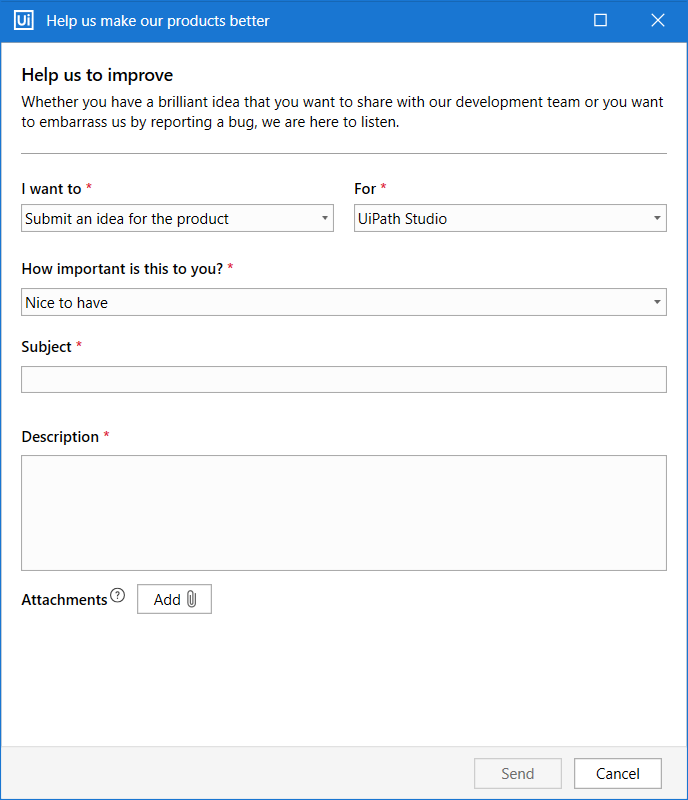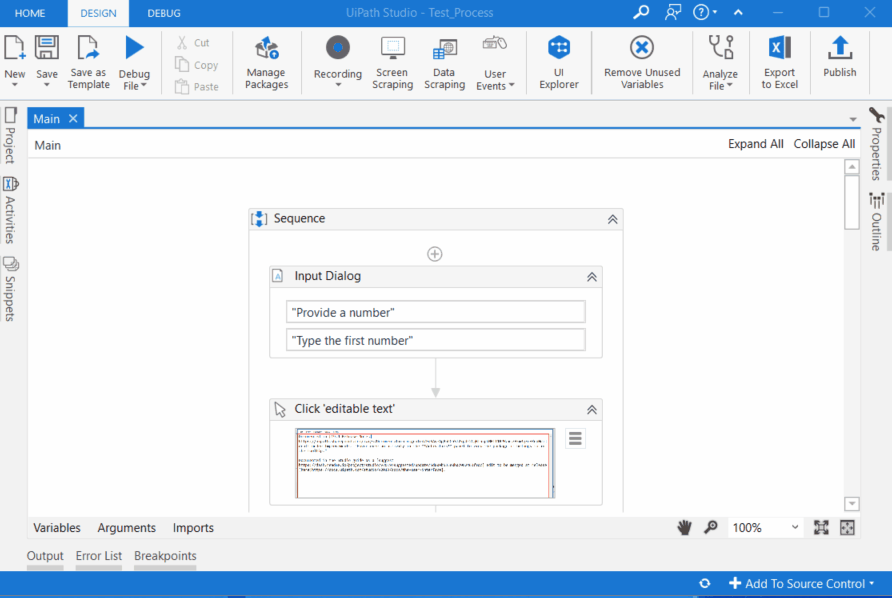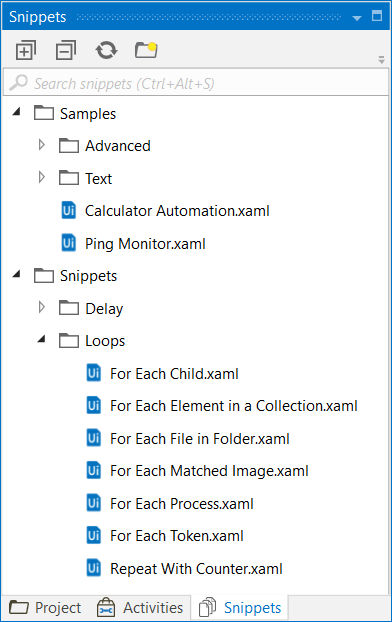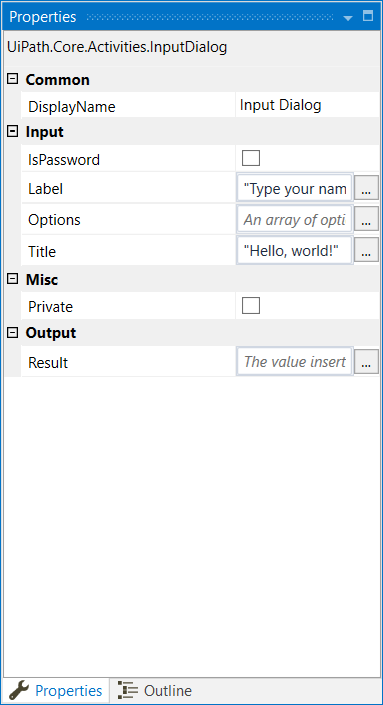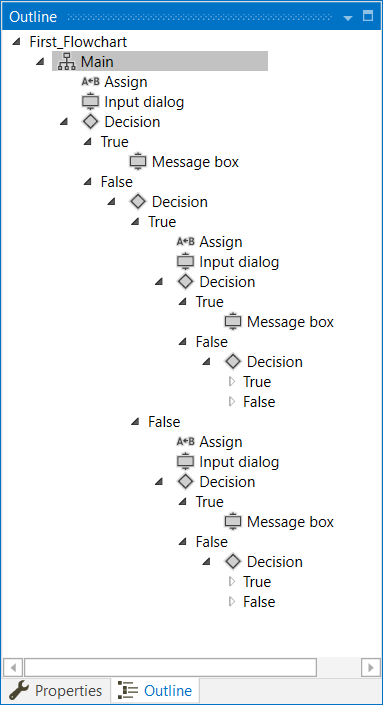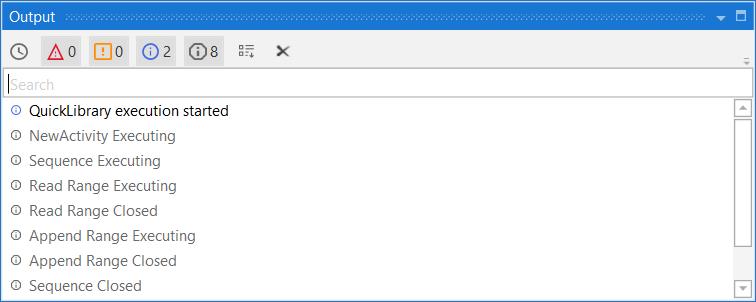UiPath Studio contains multiple panels for easier access to specific functionalities. They can be docked, act as floating windows, or the Auto-hide option can be enabled from the drop-down list.
Overview
| No. | Name | Description |
|---|---|---|
| 1 | Ribbon Tabs | Access the three main areas of Studio: Home - Go to the Studio Backstage View where you can open and create projects, configure Studio, and more. Design - Build automations using the tools available in the Command Palette, and Studio panels. Debug - Use a comprehensive set of tools to debug your workflows. For more information, see About Debugging. |
| 2 | Title Bar | Open the Command Palette. Send Feedback. Access Help resources. Sign in to your account. |
| 3 | Designer Panel | Build your automation by managing the activities added to the current workflow file. |
| 4 | Command Palette | Search within your project using the available search bars: Add activity Universal search Go to File Jump to activity |
| 5 | Variables Panel | Manage variables. |
| 6 | Arguments Panel | Manage arguments. |
| 7 | Imports Panel | Manage imported namespaces. |
| 8 | Project Panel | View the contents of your current project, manage files, folders, and dependencies, and adjust project settings. |
| 9 | Activities Panel | View all available activities and add activities to your automation. |
| 10 | Snippets Panel | Use pre-built workflows and add your own reusable automations. |
| 11 | Properties Panel | View and configure the properties of a selected activity. |
| 12 | Outline Panel | View the hierarchy of the current workflow and all available nodes. |
| 13 | Resources Panel | Add resources such as assets, queues, processes, and entities from Orchestrator. |
| 14 | Object Repository Panel | Create and reuse UI taxonomies inside and across projects. |
| 15 | Output Panel | View the output of the Log message and Write Line activities, status information regarding the execution of your project, errors generated by activities packages, and more. |
| 16 | Error List Panel | View all the errors generated when running the Workflow Analyzer. |
| 17 | Find References Panel | View all the places where an element is referenced in your project. |
| 18 | Breakpoints Panel | Manage breakpoints added to the project. |
| 19 | Status Bar | View status information and manage the Orchestrator connection and source control integration. |
The Ribbon
Ribbon Tabs
The ribbon is straightforward and can be minimized or expanded by clicking the Minimize / Expand button . It consists of the following three tabs:
- Home - create and open projects, configure Studio, or access help and license information from the Studio Backstage View.
- Design - add sequences, flowcharts and state machines to your project, install and manage activities packages, build interactions with UI elements, export workflows to Excel, and then publish your work to Orchestrator or custom feeds. Keep in mind that wizards and UI Explorer aren't visible in the Ribbon unless you install the
UiPath.UIAutomation.Activitiespackage.
- Debug - debug your workflow, while using debugging tools to set breakpoints, monitor the execution of activities step by step, and adjust the debugging speed. Open logs to view details regarding execution and any changes made to the project. For more information on debugging, check the About Debugging page.
Note:
Files that are not created during the execution of the automation project become read-only when published to Orchestrator. If your business process requires you to write in a specific file at some point, be sure to create it while designing the project.
The Title Bar
Send Feedback
There are two types of feedback that you can send directly from within Studio: Submit an idea for the product or Report a bug. Both are accessible from the ribbon by clicking the icon.
The Send Feedback feature must be used only for sending anonymous feedback to the product team. To contact our tech support team, please use the Contact Technical Support form.
Provide the following information, and then click Submit:
- From the I want to drop-down menu, pick either Submit an idea for the product or Report a bug.
- From the For drop-down menu, pick either UiPath Activities, UiPath Studio, UiPath Robot, UiPath Orchestrator or UiPath Assistant.
- From the How important is this to you drop-down menu, pick Nice to have, Important, or Critical.
- In the Subject field, add a short title.
- Add a detailed description and attach up to 6 images, videos, or text files, each with a size smaller than 10MB. The threshold for sending feedback is 3 posts in a timeframe of 5 minutes.
Help
Click the Help icon to quickly access the resources that are also available in the Help tab in Backstage View, as illustrated below:
Backstage View
This is the view you see when you first open Studio. You can also get here by clicking Home in the upper-left corner of the window. Here you can create and open projects, configure Studio, or access help and license information.
The following buttons and tabs are available in this view:
- Open - Browse to a local automation project and open it. By default, projects are created in C:\Users<current_user>\Documents\UiPath.
Note: Projects located on network folders where your user only has read permissions cannot be opened in Studio. We recommend using source control systems to collaborate on projects. - Close - Close the automation project that is currently open.
- Start - Create a new automation project or open recently accessed projects. You can create a new project from predefined templates or open a project you recently worked on. Projects can be pinned or removed from the Open Recent list, while hovering over them displays the path to the
project.jsonfile and the project description. - Templates - Create a new project based on a template. In this tab, you can view all available project templates, search and filter them by source. For more information, see Project Templates.
- Team - Manage source control integration for the automation project.
- Tools - Install extensions for Chrome, Firefox, Edge, Java, Silverlight, Citrix, Windows Remote Desktop, VMware Horizon, launch the UI Explorer, Project Dependencies Mass Update Tool, and the Repair Tool for Microsoft Office. For more information about extensions, see About Extensions.
- Settings - Change the look and feel of Studio, set global preferences, and manage activities package sources. For more information, see Configuring Studio Settings.
- Help - Directs you to product documentation, release notes, online resources, the Community Forum and the RPA Academy.
This is where you can also access a quick tutorial that helps you learn the basics of creating, publishing, and running an automation.
Note: To ensure the tutorial is completed successfully, we recommend that you pause the tutorial before making any changes to the workflow outside of those highlighted in the tutorial steps.
Information regarding product version and installation, license availability, update channel and device ID is also found in the Help tab, together with a Copy Info button for quickly copying the details to the clipboard.
The Command Palette
The Command Palette is opened by using the Ctrl + Shift + P, F3 keyboard shortcuts, or by clicking the search button. It incorporates the Add activity, the Universal search, the Go to file, and Jump to activity search bars.
Note:
Studio supports prioritizing activities by scope. Click the icon inside an activity scope and notice that the Command Palette offers suggestions of activities which fit the current scope. Support for this feature is rolling out in stages in official activities packages, check release notes periodically.
Add Activity
The Add activity search bar is opened using the Ctrl + Shift + T keyboard shortcut. You can search for activities in installed packages, and add them after the selected activity in the file. The bar automatically assigns keyboard shortcuts to the first five results, and remembers your previous findings.
Click the icon at the top or bottom of an activity from a sequence to open the Add activity search bar.
The Universal Search
The Universal search bar enables you to find snippets, activities, variables, arguments, imports, project dependencies, and files in your current project. Searches return results from all workflow files, including files that are closed.
| Option | Shortcut | Description |
|---|---|---|
| Current File | Ctrl + 1 | Lists results from the currently opened file that match the search query. |
| All Files | Ctrl + 2 | Lists results found in all files part of the current project that match the search query. |
| Activities | Ctrl + 3 | Lists results from activities that match the search query. |
| Variables | Ctrl + 4 | Finds variables in the current project that match the search query. |
| Arguments | Ctrl + 5 | Finds arguments defined in the project that match the search query. |
| Imports | Ctrl + 6 | Finds imported namespaces in the project that match the search query. |
| Project Files | Ctrl + 7 | Finds files part of the current project that match the search query. |
| Dependencies | Ctrl + 8 | Lists results found in dependencies installed to the project. |
| Snippets | Ctrl + 9 | Finds snippet files that match the search query. |
Search results persist until the next time you open the search bar if you use Universal search or Add activity. For Go to file and Jump to activity the previous search query is not persisted.
Double-click an activity or press Enter to add it to the currently opened file. Using the same commands, you can open files from under the All Files or Project Files category, or focus on the desired search result.
Default values of arguments from a process inside the Invoke Workflow activity are not searchable with the Universal Search.
Go to File
The Go to file bar searches and opens files part of the current project folder. .xaml files are opened in the Designer panel in Studio, while other files, such as screenshots or Excel files, are opened with their respective default application on your machine. Double-click or press Enter to open a file.
Note:
The Activities, Project panels, and the Command Palette support fuzzy search, which means that a list of results is returned even if the search terms don't match exactly. The search terms could be slightly incomplete, misspelled or include only the first letter of each word. For example, if you type
dciin the Activities bar, it returns the Double Click Image activity.
Jump to Activity
The Jump to activity search bar part of Command Palette helps find and focus specific activities in large workflows. It is accessed by using the Ctrl + J keyboard shortcut, or by opening using the F3 or Ctrl + Shift + P shortcuts, and selecting Jump to activity.
When opened, the Jump to activity bar displays the list of all activities in the .xaml file currently focused in the Designer panel.
Type the display name or the namespace of an activity, for example Assign. Use the keyboard arrows to select the activity and press Enter to focus it in the Designer panel.
Activities in the Jump to activity bar are arranged in the following order: container, parent, and child activities.
The Panels
The Designer Panel
The Designer panel displays your current automation project, enables you to make changes to it, and provides quick access to variables, arguments and imports.
It is possible to navigate within a diagram by double-clicking the activity you want to view. The path is displayed as breadcrumbs in the header of the Designer panel. Please note that when using multiple displays scaled differently the text in the input field part of some activities might be improperly shown.
Activities can be copied using Ctrl + C shortcut or the context menu, to a text editor, receive changes, and then copied back to the Designer panel. You can undo / redo an action you performed in the panel using the buttons in the Studio ribbon or by pressing Ctrl + Z / Ctrl + Y.
If an activity has validation errors, an error icon is displayed on the right side of the activity title bar in the Designer panel and a warning icon is displayed for all its parent activities. Clicking the icons opens the Properties panel for the activity affected by the issue and the error message is displayed at the top of the Properties panel.
Activate Pan Mode by clicking the icon, holding the Space key or pressing the middle mouse button. Use the zoom drop-down to change the zoom level and click the icon to reset it back to 100%.
The Fit to Screen icon changes the zoom in such a way that the whole workflow fits in the Designer panel. Click the icon to get an overview of the whole project and navigate through sections by adjusting the focus.
The Context Menu
The context menu enables you to perform several operations on your workflow, be it a sequence or a flowchart. You can display it by right-clicking an activity inside your workflow.
Note
If you select more activities, the menu is not displayed at all.
Field Descriptions for the Context Menu
| Option | Description |
|---|---|
| View Parent | Displays the parent of the target activity in the Designer panel. Note: This option is only displayed for child-activities, if they are opened in the Designer panel. |
| Open | Opens the selected activity in the Designer panel. Has the same result as double-click. |
| Collapse | Collapses the activity thus reducing the displayed details to "Double-click to view". You can achieve the same result by clicking the Collapse button . Note: Only displayed for sequences. |
| Expand in Place | Expands the content of the activity, displaying its detailed content. You can achieve the same result by clicking the Expand button . Note: Only displayed for sequences. |
| Cut | Removes the selected activity and places it onto the Clipboard. |
| Copy | Copies the selected activity and places it onto the Clipboard. Activities from read-only files can be copied to another workflow or a .txt file. When copying multiple activities to clipboard, their order is reversed. |
| Paste | Inserts the content of the Clipboard at the current location. |
| Delete | Deletes the target activity. Note: Since the Context menu is only displayed for a one-activity selection, you can use this command for more activities with the corresponding keyboard shortcut, Delete. |
| us | Add, edit, delete, show and hide annotations added to activities in the workflow. |
| Copy as Image | Makes a screenshot of the content displayed in the Designer panel. Note: If you want to make a screenshot of a child activity, make sure to firstly open it in the Designer panel. |
| Save as Image | Makes a screenshot of the content displayed in the Designer panel and prompts the user to set the details for saving it (Name, Type, Destination). Supported formats: JPG, PNG, GIF, XPS. |
| Create Variable | Creates a variable in the Variable panel. |
| Auto Arrange | Automatically arranges activities in a flowchart. |
| Remove Surrounding Sequence | Removes the selected Sequence activity from the Designer panel. The activities that it contains are moved to the parent sequence. |
| Surround with Try Catch (Ctrl + T) | Inserts the activity in a Try Catch statement. Note: A Try Catch statement is used for handling exceptions caused by data or coding errors. The Try clause encloses the activity to be checked for exceptions. The Catches clause is the exception handler. The Finally clause is used for executing an activity regardless of the status of the first two clauses. |
| Extract as Workflow | Creates a new workflow containing the targeted activity with the purpose of breaking down a large project into smaller ones. In the place of the extracted activity an Invoke <new> workflow activity is created which enables you to edit and import arguments from the newly created workflow. The arguments are created automatically from the variables used in that activity. The Invoke <new> workflow activity automatically maps the local variables to invoke arguments for the extracted workflow. |
| Open Workflow | Opens a workflow created using the above option. |
| Enable Activity | Enables a previously disabled activity. |
| Disable Activity | Disables an activity, which is then placed inside a Comment out activity. |
| Toggle Breakpoint | Marks the selected activity as a breakpoint for debugging. Breakpoints can also be toggled by clicking the Breakpoint button in the Execute tab. You can trigger a breakpoint for one activity at a time. |
| Edit Breakpoint Settings | Opens the Breakpoint Settings window. |
| Run to this Activity | Debugs the project and stops before this particular activity is executed. |
| Run from this Activity | Starts debugging from this activity. |
| Show All Conditions | Displays all conditions defined in your project (Properties panel > Conditions). Note: This option is only displayed for flowcharts when you right-click an empty space inside the project; it is not displayed if you right-click an activity in your flowchart. |
| Hide All Conditions | Hides all displayed conditions. Note: This option is only displayed for flowcharts when you right-click an empty space inside the project; it is not displayed if you right-click an activity in your flowchart. |
| Set as Start Node | Connects the selected activity with the Start node. Note: Only displayed for flowcharts. |
| Set as Initial State | Connects the State Machine specific activity to with the Start node. Note: Only displayed for state machines. |
The context menu is also displayed for tabs in the Designer panel. The following options are available:
| Option | Description |
|---|---|
| Close | Closes the active tab. |
| Close Others | Closes all tabs but the active one. |
| Close All Documents | Closes all tabs. |
| Float | Undocks the target tab and changes it to a floating state. |
| Pin Tab | Pins the target tab in the Designer panel. Note: The tab pinned last is always moved in front of all other existing tabs (pinned or not). The position of a pinned tab can only be changed relative to other pinned tabs. |
| New Horizontal Tab Group | Splits the screen horizontally, enabling you to see two or more instances of the Designer panel within the same screen. The target project is moved onto the panel on the right. Note: Only displayed when your project contains two or more tabs and, implicitly, workflows. |
| New Vertical Tab Group | Splits the screen vertically, enabling you to see two or more instances of the Designer panel within the same screen. The target project is moved onto the panel at the bottom. Note: Only displayed when your project contains two or more tabs and, implicitly, workflows. |
| Move to Previous Tab Group | Moves the target tab onto the previous Designer panel displayed. Note: Only displayed if you had used the New Vertical Tab Group or New Horizontal Tab Group options before. |
| Move to Next Tab Group | Moves the target tab onto the next Designer panel displayed. Note: Only displayed if you had used the New Vertical Tab Group or New Horizontal Tab Group options before. |
The Project Panel
The Project panel enables you to manage project files, dependencies, and configure project settings. For more information, see Managing Projects.
The Activities Panel
The Activities panel shows available activities that can be added to the current workflow. You can search for activities by name and optionally by description using the search box at the top of the panel, navigate through them using navigation keys, and press Enter to add the selected activity to the currently opened file.
Note:
The search box can be used for finding activities by their class name, regardless of the interface language set in Studio.
Hovering over an activity in the panel displays the package it belongs to and its description. To add an activity to the list of favorites, right-click it and select Add to favorites.
Right-click an activity in the panel and select Create Test Bench to test out one or more activities before adding them to a project. Read more about this here.
Customizing the Activities Panel
Click the View Options button at the top of the panel to open a menu that allows you to customize the panel. See the following table for a list of available options.
| Option | Description |
|---|---|
| Show Favorites | Show a section with favorite activities. This option is selected by default. |
| Show Recent | Show a section with the ten most recently used activities. This option is selected by default. |
| Show Available | Show all available activities. This option is selected by default. |
| Show Compatibility | Option currently not used. This option is not selected by default. |
| Show StudioX | Show activities designed for the StudioX profile. This option is not selected by default. |
| Show Classic / Modern | Show modern UI Automation activities in projects using the classic design experience or show classic UI Automation activities in projects using the modern experience. This option is not selected by default. |
| Show Categories | Group activities by the category they belong to. This option is selected by default. |
| Group by Packages | Group activities by the package they belong to. This option is not selected by default. |
| Search by Description | When searching in the panel, search in activity descriptions, not just in activity names. This option is not selected by default. |
| Pin Favorites | When searching in the panel, keep favorite activities always visible. Available if Show Favorites is selected. This option is not selected by default. |
The Snippets Panel
The Snippets panel enables you to easily reuse automations. It includes, by default, multiple samples and snippets.
You can add your own by clicking the Add Folder button and selecting a directory from your hard drive. Empty folders are not displayed.
To remove a folder, right-click it and select Remove.
The Properties Panel
The Properties panel is contextual and enables you to view and change the properties of a selected activity. When selecting two activities in the same workflow, common properties can be modified from the Properties panel.
The Expression Editor
The Expression Editor is accessible with the Ctrl + Shift + E keyboard shortcut when used inside activity input fields. It is also available from the Properties panel, from fields that require inputting text, and from the body of an activity, by adding text directly in the required fields.
Expressions can be written on multiples lines. Keyboard shortcuts for creating variables and arguments directly in expressions are available.
Use Ctrl + F inside the editor to open the search and replace capabilities. Select part of an expression and press Ctrl + F3 to add the text to the search field. Hold the Ctrl key to make the search pane semi-transparent and see the text behind it.
The Outline Panel
The Outline panel displays the project hierarchy, and all available nodes. You can highlight activities in this panel by selecting them in the Designer panel, or you can go to a specific activity by selecting it in the Outline panel.
The Output Panel
The Output panel enables you to display the output of the Log Message or Write Line activities, among other things. Exceptions for packages are also displayed in this panel.
From the Output panel, you can show or hide messages that have different log levels (errors, warnings) by clicking the buttons in the panel’s header. Double-clicking a message displays further details about it, with the option to copy information.
When searching for a log in the Output panel and selecting an item from the search results list, the log is highlighted.
The Export Logs button is used for exporting logs into a .txt file. It exports timestamps and error message details as well. Exporting filtered logs is available. For example, if you want to export only trace level logs, filter the list and then use the Export Logs button.
When debugging, the Output panel shows logs for when an activity starts executing and until it ends. This can be enabled from the Log Activities option in the Debug tab.
The Error List panel displays errors found in the file or project during the validation process, together with errors generated by Workflow Analyzer rules.
The Clear All button erases all info displayed in the Output panel. Logs and other data stored in this panel are erased when a workflow is run. The Output panel displays up to 2,000 lines at a time.
The Find References Panel
The Find References panel displays results for references you search for in your project. To find every place in the project where an element is referenced, right-click it and select Find References. This works for the following:
- Files in the Project panel
- Activities in the Activities panel
- Variables in the Variables panel
- Arguments in the Arguments panel
- Descriptors in the Object Repository panel
The Resources Panel
The Resources panel in Studio can load assets, queues, processes, and entities, provided that the Robot is connected to Orchestrator. Read the Connecting Robots to Orchestrator page to find the steps.
If the Robot connected to Orchestrator is of type Standard, then the Resources panel can display only the Classic folder which has this Robot provisioned.
If the Robot is of type Floating, the panel can display resources from all classic and modern folders that this Robot has access to. Find out more about robots and folders in the Orchestrator Guide.
Notes:
- When using a classic, manually provisioned robot, it must be granted
Viewpermissions for the corresponding resources (i.e. Assets, Queues, and Processes) to appear in the panel. Read more about setting up Roles and permissions in Orchestrator.- If there are both classic and modern folders in Orchestrator and you are connected to Orchestrator using a robot from a modern folder (you signed in to your account or connected using a machine template key), the processes in the classic folders are not available in the Resources panel. To have access to the processes from a classic folder, connect to Orchestrator using a classic robot with a standard machine key connection.
Selecting an Orchestrator Folder
The folder from which resources are currently loaded in the panel is displayed in the Studio status bar. You can switch to a different folder that you have access to by clicking the current folder name, and then selecting another Orchestrator folder from the menu that appears. In addition to the resources that are available in Studio, the folder selection also determines the default targets available when publishing your processes.
To load resources into the panel, click the Refresh button at the top of the panel. Hover over the folder name in the status bar to see the Orchestrator URL.
Note:
Logs generated from processes located in subfolders are visible in Orchestrator only if the subfolder is selected in the Resources panel.
Using Orchestrator Resources In Your Projects
Drag and drop assets, queues, or processes from the Resources panel directly to your automation project. Upon doing so, suitable activities are suggested in the Add activity search bar. For example, after dragging a queue in your project, pick the Add Queue Item activity from the Add activity search bar and notice that the queue was automatically assigned to the activity's Queue Name property.
You can also right-click any item in the Resources panel, and then select Copy to copy its name and use it in activities that interact with such resources.
Debugging Panels
The following panels are available to help you debug your projects: Breakpoints, Call Stack, Locals, Watch, and Immediate.
The Status Bar
In the status bar, you can view status information and access options related to Orchestrator and source control. This is where you can also view which language is used for expressions in the project (VB or C#).
- Orchestrator/Cloud Connection - Click to access Orchestrator options: sign in to your cloud account, disconnect from Orchestrator (if connected with a machine key), and refresh resources.
- Orchestrator Status - Displays the Orchestrator connection status. When connected to Orchestrator, the currently selected folder is displayed. You can click the name of the current folder to view a list of available folders and select another folder from which to sync resources.
- Source Control - Depending on whether the project is connected to a source control repository, different options are available to help you manage source control integration. For more information, see About Version Control.
Updated about a year ago





